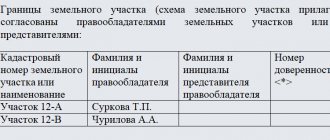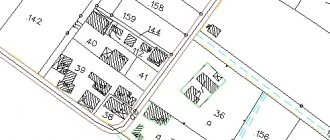Interesting data
In the Kurortny district of St. Petersburg, the cost of 1 hectare of land is about one or one and a half million rubles. And at the same time, inside the city limits, some sellers offer land plots at a price of 300-500 thousand rubles per hundred square meters. In the Moscow region, the average cost of supply on the primary market is 200-220 rubles per 100 m2, and very close to the capital - in the neighboring Tula region - you can find offers 20-25 times cheaper.
Checking a plot of land before purchasing should cover all possible aspects, both past and future. The plot should not be the subject of litigation or encumbered, and all the nuances of the transaction should be previously agreed upon and indicated in the contract. The second point is very relevant for “problem” land: seized, mortgaged, encumbered.
The market for such real estate tempts buyers with low prices, but has so many pitfalls that the purchase entails more problems than benefits. Check the land plot for encumbrances - protect yourself from unnecessary problems.
Definition and legislation
Encumbrances on a land plot mean prohibitions and conditions imposed on it that limit its use. Moreover, these restrictions are often not removed with a change in the owner of the site and are tied to the land itself, and not to the owner.
The encumbrance of a site can be understood as:
- restriction of land in circulation (for example, having it as collateral for a mortgage loan);
- providing it for use by other persons (for example, easement);
- limited permitted use (for example, a ban on industrial development in environmental zones).
Article 11.8 of the Land Code describes the ways in which encumbrances may arise on a site:
- in clause 2, the right to unlimited and free use;
- in clause 4, the specifics of the lease agreement;
- clause 5 – methods for establishing the boundaries of easements.
Locally, the legal norms of the Land Code regarding encumbrances on land plots are supplemented by municipal legislative acts.
What is this?
Encumbrance on a plot is an action aimed at reducing the freedom to dispose of land. The Land Code regulates the owner’s capabilities and determines the situations when an encumbrance arises. The municipality supplements the law with local acts. When is land considered encumbered? Under the following conditions:
- Easement: An interested group or person has access to land, which includes the right of way or installation of power lines, pipes. There is a distinction between private and public subordination. Is temporary or permanent.
- Mortgage: the owner took out a loan, and in return mortgaged the land to the bank. Transactions with it must be approved by the bank, since the property is theirs for the duration of the loan payments.
- Rent exceeding 12 months. Long-term contracts are subject to registration with Rosreestr. It is permitted to sell the property, but any lease obligations entered into will pass to the buyer.
- Seizure of land. Most often, conscription arises as a result of debts. The plot is sold and the owner's minus is paid off with the proceeds.
- Historical value: arises when an architectural monument is located on the site.
This is interesting: Exchange of a catamaran, how to exchange a catamaran in a store for a new one
Any of the restrictions are subject to official recording in the Registrar's Office. The register is available to any citizen of the Russian Federation. Since the information is public, every buyer should check the site for encumbrances before the transaction.
Types of encumbrances
Russian legislation contains the following types of encumbrances in relation to plots:
- Easement . This type of encumbrance is established when it is necessary to provide access to a site for a third party or group of persons. An easement can be expressed in the form of the right to pass/pass through a site (for example, if a road to a reservoir runs through the site); the right to lay communications (for example, gas pipes or power lines); the right to use the site for the purposes of reclamation, grazing or driving livestock. An easement can be private (imposed in the interests of a specific person) or public (in the interests of a group of persons). An easement can be imposed for a specific period (for example, for the duration of repair work) or for an unlimited time.
- Mortgage (collateral). When the plot is under mortgage, it is limited in circulation, since it is pledged to the financial institution that issued the money for its purchase. Concluding purchase and sale transactions for land plots is permitted in this case only with the consent of the creditor bank.
- Long-term rental (for a period of one year). By law, lease agreements concluded for a period of at least one year must be registered with Rosreestr. If there is such an encumbrance, the owner has the right to alienate the rights to the plot, but the lease agreement will continue to be valid after the purchase and sale transaction. This fact must be taken into account by a potential buyer.
- Concession. This type of encumbrance has a similar meaning to a lease agreement. According to it, the owner transfers the plot to the concessionaire for use for a certain fee. Typically, such an agreement is concluded for the construction of a building and structure and further profit.
- Judicial arrest as part of enforcement proceedings. It is usually imposed due to the owner's debts. It is assumed that this plot will be sold at auction, and the proceeds will be written off against the resulting debt. Therefore, the owner does not have the right to sell and alienate the site under other agreements.
- Trust management. The encumbrance implies that the operation of the site is carried out by an appointed manager.
- Seizure of land for state needs.
- Encumbrances associated with real estate on a land plot that has the status of cultural monuments.
What it is
Land plots can be transferred to citizens and legal entities for ownership, as well as for temporary or indefinite use.
In each of these cases, the owners have a legal right to use the land for its intended purpose (for example, agricultural land can only be used for growing agricultural products or other similar purposes). Restrictions on the rights of owners or possessors are permitted only in cases provided for by law or based on the terms of contracts. Legislative acts allow the following forms of encumbrances on land:
- prohibitions and restrictions established in regulations and targeted restrictions on certain areas of land use (for example, a ban on constructing industrial and production facilities on lands allocated for personal farming);
- restrictions associated with the emergence of a public or private easement, i.e. the ability of third parties to use someone else's land plot;
- prohibitions and restrictions related to the emergence of legal claims - arrest to secure a claim or to ensure enforcement actions;
- restrictions on the ownership and disposal of land that arise with the consent of the copyright holder (for example, a mortgage when purchasing land on credit);
- temporary restrictions associated with the conclusion of a lease agreement (when transferring ownership of land, lease relations are maintained for the entire duration of the agreement).
Thus, various types of restrictions can arise directly by force of law, under the terms of contracts and agreements, as well as on the basis of judicial acts.
Based on the analysis of the norms of the Land Code of the Russian Federation and the Civil Code of the Russian Federation, we can distinguish the following types of encumbrances that can be established on land plots:
- public and private easements;
- mortgage encumbrance;
- a lease agreement whose term exceeds one year;
- arrest imposed by a judicial act or resolution of an official of the FSSP;
- trust management;
- concession.
In some cases, a prohibition or encumbrance may arise based on the special status of the property located on the site. For example, a historical heritage site automatically imposes restrictions on the corresponding land area.
How to find out encumbrances?
If there are certain encumbrances in relation to the site, then a note about this must be included in the unified register of rights (now it is the Unified State Register of Real Estate).
Rosreestr is responsible for maintaining the specified legal framework. Information from the Unified State Register can be obtained by any interested party and is open.
Therefore, checking the site for the presence of encumbrances is an integral stage before concluding a purchase and sale transaction.
Information on the presence of encumbrances is contained in the Public Cadastral Map of Rosreestr. To obtain the necessary information, simply enter the cadastral number of the land plot into the search bar.
But the information received here is suitable only for the personal purposes of the person concerned and does not serve as official documentary evidence of the fact that there are no restrictions.
A certificate of absence of encumbrances or an extract from the Unified State Register can be obtained in one of the following ways:
- Contact the regional office of Rosreestr.
- Through MFC.
- Submit your request electronically or send it by mail.
To do this, submit an application for an extract from the register indicating the cadastral number of the plot, attach a copy of the passport of the interested person and a receipt with paid state duty. The statement is provided in electronic or paper document format.
The extract contains up-to-date information on cadastral registration and title information. All encumbrances that apply to the site will also be indicated here.
Information about the presence or absence of encumbrances must be contained in the certificate of ownership of the land plot. But it’s better to further protect yourself and request a current extract from the Unified State Register of Real Estate at least a month before the transaction.
Encumbrance agreement
Since the imposition of encumbrances is subject to mandatory state registration, the parties must formalize their legal relations in contractual form. Depending on the type of encumbrance, they conclude:
- lease or concession agreement;
- trust agreement;
- mortgage agreement.
Such agreements must clearly identify the parties to the relationship: the borrower and the bank, the owner and the lessee, the owner and the concessionaire.
They must contain detailed information about the land plot: its area, cadastral number, permitted use, etc.
In addition to general standard clauses, these agreements include information about the duration of the encumbrance and the procedure for its removal (for example, after making the last payment on the loan). The encumbrance agreement must also specify the grounds for its imposition.
If encumbrances are imposed by a court decision (for example, we are talking about enforcement proceedings or easements), then the conclusion of an agreement is not required.
A one-time payment from the funded part of the pension - how to arrange it correctly? You will find all the information you need about applying for a pension in our article.
Read about raising the retirement age and related changes in payments in this article. We have the most detailed information!








